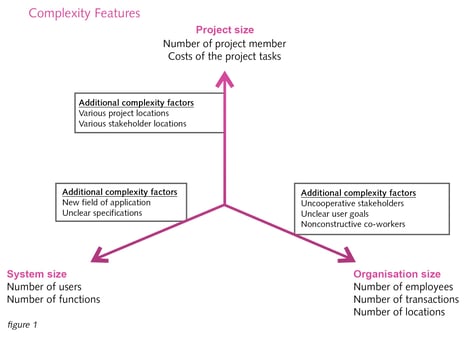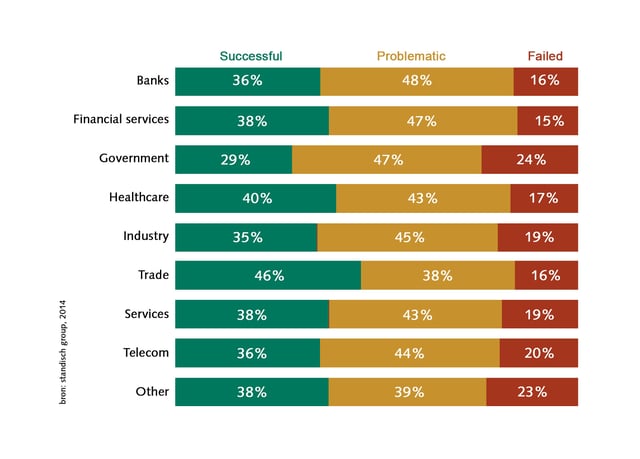 Since 2015, Antwerp Management School and Standish Group have been conducting research on the complexity of IT projects. It's not simple to explain what the complexity IT projects can entail. We associate complexity with situations and problems with a high degree of difficulty. Furthermore, in a specific project, some people can experience a very high complexity, while others don't. That would mean that there is no objective measure for complexity. That would be unsatisfactory for the clients as well as the contractors. However, there is - for the first time in IT history - something that can be done, through the statistical analysis of big numbers of comparable, successful, failed and problematic IT projects.
Since 2015, Antwerp Management School and Standish Group have been conducting research on the complexity of IT projects. It's not simple to explain what the complexity IT projects can entail. We associate complexity with situations and problems with a high degree of difficulty. Furthermore, in a specific project, some people can experience a very high complexity, while others don't. That would mean that there is no objective measure for complexity. That would be unsatisfactory for the clients as well as the contractors. However, there is - for the first time in IT history - something that can be done, through the statistical analysis of big numbers of comparable, successful, failed and problematic IT projects.
The complexity of IT projects can be devided into three components that influence each other (figure 1): size of the organisation, size of the information system that is to be implemented, and size of the project.
Size of the organization
The size of the organisation is of great importance to the complexity of a project, because smaller projects in big enterprises don't perform as well as comparable projects in smaller organisations. Ofcourse, it cannot all be blamed on size. The real reason is that organising and communicating become more tiring and difficult when more people are involved.
Size of the information system that is to be implemented
The branch in which the projects take place is also of importance. The best project results come out of retail companies and the worst come out of government institutes. The size of the system that is to be developed, is a component for determining the complexity of the project. This size can be indicated by the number of functions that are to be developed and implemented, or by the number of (future) users.
There's a number of complicating factors. The most important ones from the research are "the quality of the specifications" and "basic applications or brand new applications". It makes a world of difference whether or not a system is specified completely and precisely. When that's not the case, it has inmediate repercussions on the planning, costs and quality of the system. When it involves financial infomation systems, that have been implemented before (elsewhere), it is easier than an information system that has not been used, or has only sporadically been used before.
Size of the project
The biggest complexity factor is the scale, size or scope of the project that has to be carried out. That is no surprise. We've known for dozens of years that with IT projects comes great risk, but we've never seen how big these risks actually are. That failure and success criteria play a big role is something that has been published before as well. However, we've never known which combination is fatal. This statement can actually only be solidly made on the foundation of a great number of independent observations.

Green, orange and red traffic-lights for IT projects
The Standish Group International in Boston, USA* is researching the complexity of IT projects together with Antwerp Management School. Over a hundred thousand IT projects are in the Standish database and have a big number of characteristics concerning envolvement in the enterprise, the information system and the project. Statistical analysis showed the most important complexity factors. For insiders in de IT industry, these are recognizable problems. The Standish complexity matrix distinguishes between 25 complexity categories: green (safe, little risk), yellow (warning, professional general management and projectmanagement wanted), and red (danger, reconsideration wanted and possible want for canceling).
Code Red
For the "red" projects it's to be recommended to execute a "singe project investigation". That means searching the database for a set of IT projects that coincide with the investigated project for more than 90%. In the case of a successful selection, the report can be obtained automatically. In this report it says, among other things, how many closed off and broken down projects have succeeded or failed, or have been slowed down, and to what degree. IT projects with higher complexity have a bigger chance at failing. IT projects with labour costs over 10 million failed. In 44% of the cases the system was not implemented at all. That does not make for the opposite to be true: projects that fail are not complex by definition.
* STANDISH Group International in Boston, USA
STANDISH is a research advisory company specialized in researching the results of IT projects. Since 1994, Standish has published a market study on the current situation of the IT field every two years. By now, the database contains more than 100.000 terminated projects. The codification of the projects in the Standish database, is done on the foundation of written surveys among CIO's, complemented by personal interviews by Standish employees. A big number of features, that give an idea of project, is captured, from the development to the implementation of the system. They also register the most important reasons for the failure or success of the projects, according to the CIO. 60% of the projects took place in the USA and were performed in big (50%), medium sized (30%) and small (20%) organizations. The results of the IT projects, that were analyzed according to size, showed big differences.


